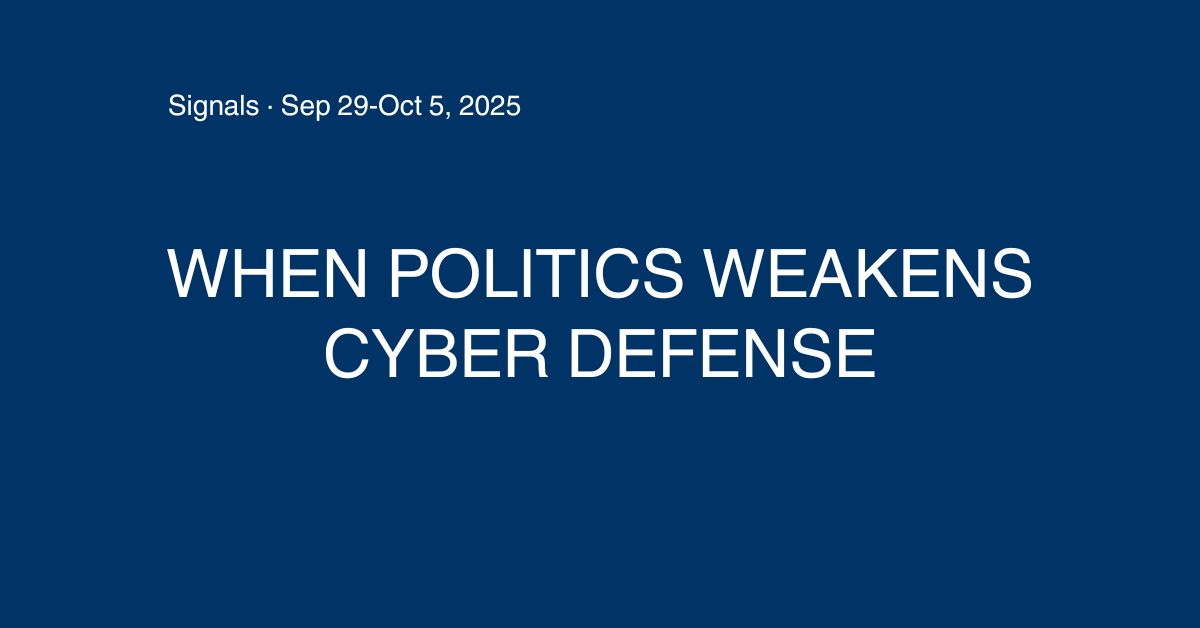Not every cyber crisis begins with a breach. Sometimes, it starts with a political decision. Or the lack of one.
Last week, the CISA 2015 Information-Sharing Act expired. At the same time, the U.S. government entered a partial shutdown, forcing suspensions at CISA and NIST. On paper, it’s bureaucratic housekeeping. In practice, it silences part of the nation’s digital early-warning system.
For a decade, that law allowed companies to share threat intelligence with the government without fear of legal exposure. It protected collaboration across sectors – hospitals, utilities, banks – and enabled CISA to correlate signals that no private vendor could see alone. Now, those exchanges face liability risk and antitrust ambiguity, just as the volume of supply-chain and SaaS attacks hits record levels.
The System Goes Quiet
The first consequence is subtle but immediate: CISA can no longer guarantee safe harbor for shared indicators or incident reports. Federal teams that normally triage early signs of coordinated attacks are partially offline. And without legal protection, many private-sector partners will stop sharing threat data altogether.
This isn’t a theoretical loss. The MS-ISAC, which coordinates security for state and local governments, is already preparing a shift to fee-based services as federal funding lapses. For small towns and school districts, that cost can be prohibitive.
The outcome: slower detection, isolated responses, and a patchwork of underfunded local SOCs. All while attackers increasingly exploit shared platforms like Salesforce, Oracle, and GitLab to move laterally between organizations. A single compromised token can now cascade through dozens of vendors before anyone notices. Without a functioning federal exchange, the alerts may arrive later, if at all.
When Governance Becomes Attack Surface
The expiration of a single law shouldn’t cripple security coordination. Yet it does because cybersecurity doesn’t always fail at the point of attack. Sometimes it fails at the point of governance. The U.S. system was built on a public-private partnership model. Federal agencies absorbed the legal risk of data sharing; the private sector contributed telemetry. That balance kept incentives aligned until Congress failed to renew it.
Now, the very mechanisms designed to improve resilience are paralyzed by liability uncertainty. Sharing indicators without a safe harbor could expose companies to lawsuits. Not sharing could expose many to attacks. Either way, the attacker wins.
It’s a reminder that policy continuity is part of cyber resilience. Budgets, compliance programs, and even security architectures depend on predictable rules of engagement. When those rules lapse, the market improvises, but not evenly. Large enterprises will pay for private intel feeds; smaller ones will fall behind.
Market Moves: From Regulation to Substitution
In cybersecurity, regulation usually drives demand. This time, deregulation – or rather, deauthorization – does. The intelligence-sharing vacuum will boost demand for:
- Private TI networks with auditable data handling and cross-sector coverage
- Managed response retainers for SLTT and regulated industries
- SaaS-driven threat portals offering real-time observables with legal safe-harbor language
- Insurance-aligned compliance services bundling DFIR and evidence capture
The next wave of winners will be companies that make collaboration safe again, not through policy, but through product. Think governance-by-design: secure enclaves, traceable attribution, and encrypted exchange that satisfies legal teams as much as SOC analysts.
Beyond the Beltway
Globally, this episode will not go unnoticed. Europe, the UK, and Japan have been tightening their cyber coordination frameworks, investing in sovereign SOCs and mandatory reporting channels. The U.S., by contrast, just signaled fragility in its cyber governance.
Allies will adapt, insurers will recalibrate exposure models, and adversaries will test the gap. The market may respond with innovation or with fragmentation. Either way, policy paralysis becomes an externality priced into cyber risk. The episode exposes a broader truth: Digital resilience isn’t just about encryption, segmentation, or AI. Governance shouldn’t pause when politics do.
What to Watch
- Congressional reauthorization of CISA 2015, and whether liability protections return in full or diluted form.
- MS-ISAC funding transition: will it move to a subscription model, and how quickly?
- Growth of private intel consortiums, particularly insurer-backed and sector-specific networks.
- Emergence of regional SOC frameworks: state or EU-style coordination filling national gaps.
- Corporate governance updates: boards adding “intel risk” to enterprise risk registers.
Bottom Line
Political gridlock can disable cyber defenses faster than hackers can. When public mechanisms freeze, the market scrambles to reinvent them, often less efficiently, sometimes more expensively. Security depends as much on legislation uptime as on system uptime. And every lapse of governance is an invitation for someone else – whether vendor, insurer, or attacker – to fill the gap.
